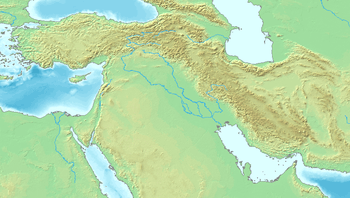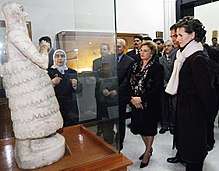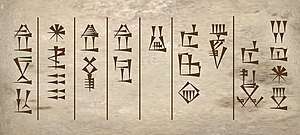Iku-Shamagan
Iku-Shamagan (𒄿𒆪𒀭𒊭𒈠𒃶, i-ku-Dsha-ma-gan)[3][4] was a King of the second Mariote kingdom who reigned c. 2500 BCE. He is one of three Mari kings known from archaeology, Ikun-Shamash probably being the oldest one.[5] Another king was Lamgi-Mari, also known from an inscribed statue.[6][7][8]
| Iku-Shamagan 𒄿𒆪𒀭𒊭𒈠𒃶 | |
|---|---|
| King of Mari | |
.jpg) | |
| Reign | c. 2500 BC Middle Chronology |
| Predecessor | Ikun-Shamash |
| Successor | Ishqi-Mari |
| King of Mari | |

In their inscriptions, these Mari kings used the Akkadian language, whereas their contemporaries to the south used the Sumerian language.[5]
Vase
A vase mentioning Iku-Shamagan "in an early semitic dialect" is also known:[9][10]
"For Iku-Shamagan, king of Mari, Shuweda the cup-bearer, son of ... the merchant, dedicated this vessel to the river god and Ishtarat"
Statue
Iku-Shamagan is known from a statue with inscription, discovered by André Parrot in 1952.[5][12][13] The statue, in the National Museum of Damascus, was restored by the Louvre Museum in 2011.[14]
Iku-Shamagan's votive statue was dedicated through an inscription on the back of the statue:[14]
𒄿𒆪𒀭𒊭𒈠𒃶 / 𒈗𒈠𒌷𒆠 / 𒀋 / 𒊕𒂅 / 𒊨𒋤 / 𒀭𒈹𒍝𒍝 / 𒊕𒄸𒁺i-ku-Dsha-ma-gan / lugal ma-ri2ki / abba2 / sa12du5 / dul3su3 / DMUSZ3xZA.ZA / sa12rig9
"Of Iku-Shamagan, king of Mari, his surveyor has dedicated the statue to Ninni-zaza"
The statue was discovered in Mari, in the Temple Ninni-zaza.[14]
The statue was heavily damaged during the conquest by the armies of the Empire of Akkad circa 2300 BCE.[14][16]
 Asma al-Assad and Marisa Leticia looking at the statue of Iku-Shamagan in the National Museum of Damascus
Asma al-Assad and Marisa Leticia looking at the statue of Iku-Shamagan in the National Museum of Damascus.jpg) Statue of Iku-Shamagan with votive inscription on the back of the right shoulder.[17][18] National Museum of Damascus
Statue of Iku-Shamagan with votive inscription on the back of the right shoulder.[17][18] National Museum of Damascus.jpg) Iku-Shamagan (detail)
Iku-Shamagan (detail)
King Iku-Shamagan of Mari | ||
| Regnal titles | ||
|---|---|---|
| Preceded by Ikun-Shamash |
King of Mari 2500 BC |
Succeeded by (...) Ishqi-Mari |
Citations
- Spycket, Agnès (1981). Handbuch der Orientalistik (in French). BRILL. p. 87–89. ISBN 978-90-04-06248-1.
- Parrot, André (1953). "Les fouilles de Mari Huitième campagne (automne 1952)". Syria. 30 (3/4): 196–221. doi:10.3406/syria.1953.4901. ISSN 0039-7946. JSTOR 4196708.
- "CDLI-Archival View". cdli.ucla.edu.
- LAMBERT, Maurice (1970). "Les inscriptions des temples d'Ishtarat et de Ninni-zaza". Revue d'Assyriologie et d'archéologie orientale. 64 (2): 168–171. ISSN 0373-6032. JSTOR 23283417.
- Spycket, Agnès (1981). Handbuch der Orientalistik (in French). BRILL. p. 86. ISBN 978-90-04-06248-1.
- Art of the First Cities: The Third Millennium B.C. from the Mediterranean to the Indus. Metropolitan Museum of Art. 2003. p. 148. ISBN 978-1-58839-043-1.
- Spycket, Agnès (1981). Handbuch der Orientalistik (in French). BRILL. p. 88. ISBN 978-90-04-06248-1.
- Alfred Haldar (1971). Who Were the Amorites. p. 16.
- Margueron, Jean-Claude (2018). Akh Purattim 2 (in French). MOM Éditions. p. 86. ISBN 978-2-35668-183-6.
- Art of the First Cities: The Third Millennium B.C. from the Mediterranean to the Indus. Metropolitan Museum of Art. 2003. pp. 155–156. ISBN 978-1-58839-043-1.
- "CDLI-Archival View". cdli.ucla.edu.
- Parrot, André (1953). "Les fouilles de Mari. Huitième campagne (automne 1952)". Syria. Archéologie, Art et Histoire. 30 (3): 196–221. doi:10.3406/syria.1953.4901.
- Parrot, André (1953). "Les fouilles de Mari Huitième campagne (automne 1952)". Syria. 30 (3/4): Plates XXI-XXII. doi:10.3406/syria.1953.4901. ISSN 0039-7946. JSTOR 4196708.
- "Louvre Recherche Scientifique" (PDF). 2011: 180–181. Cite journal requires
|journal=(help) - "CDLI-Archival View". cdli.ucla.edu.
- Statue of Iku-Shamagan at time of discovery "Mission Archéologique de Mari. Volume III only : Les Temples D'Ishtarat et de Ninni-Zaza by PARROT André on Meretseger Books". Meretseger Books.
- Spycket, Agnès (1981). Handbuch der Orientalistik (in French). BRILL. p. 87–89. ISBN 978-90-04-06248-1.
- Parrot, André (1953). "Les fouilles de Mari Huitième campagne (automne 1952)". Syria. 30 (3/4): 196–221. doi:10.3406/syria.1953.4901. ISSN 0039-7946. JSTOR 4196708.
